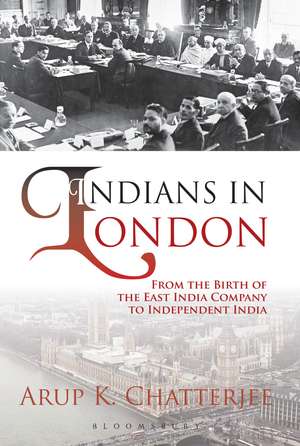Indians in London: From the Birth of the East India Company to Independent India
Autor Dr Arup K. Chatterjeeen Limba Engleză Hardback – 29 iul 2021
Preț: 519.28 lei
Preț vechi: 736.40 lei
-29% Nou
Puncte Express: 779
Preț estimativ în valută:
99.37€ • 102.67$ • 82.66£
99.37€ • 102.67$ • 82.66£
Carte disponibilă
Livrare economică 26 februarie-12 martie
Preluare comenzi: 021 569.72.76
Specificații
ISBN-13: 9789389449181
ISBN-10: 9389449189
Pagini: 570
Dimensiuni: 135 x 216 x 34 mm
Greutate: 1 kg
Editura: Bloomsbury Publishing
Colecția Bloomsbury Academic India
Locul publicării:New Delhi, India
ISBN-10: 9389449189
Pagini: 570
Dimensiuni: 135 x 216 x 34 mm
Greutate: 1 kg
Editura: Bloomsbury Publishing
Colecția Bloomsbury Academic India
Locul publicării:New Delhi, India
Caracteristici
The emergence of a little colony of Indian barristers, civil servants, diplomats, entrepreneurs and travellers in mid-Victorian London to the rise of Dadabhai Naoroji, Romesh Chunder Dutt, WC Bonnerjee, GK Gokhale, MK Gandhi, MA Jinnah and many others.
Notă biografică
Arup K. Chatterjee is an Associate Professor at O.P. Jindal Global University. He is the Founder Chief Editor of Coldnoon: International Journal of Travel Writing & Travelling Cultures, which he has run from 2011 to 2018. As a writer, he has authored The Purveyors of Destiny: A Cultural Biography of the Indian Railways (2017), The Great Indian Railways: A Cultural Biography (2018), Indians in London: From the Birth of the East India Company to Independent India (2020) and The Great Indian Railway Saga (2020).
Cuprins
A Chronicle Foretold Act I-What Trade Art Thou Scene I The BaptismScene II Brewing a Colony in a Tea CupScene III An Indian Fish, Dead or Alive Act II-Lays of Little Bengal Scene I An Armenian in the City Scene II The Orient Arrives Scene III From an Indian Harem to a London Tavern Scene IV Nurseries for Nabobs Scene V For the Sake of MahometAct III-Begums, Baboos, Seamen and SpiritsScene I Married to EmpireScene II Ragtag of the Raj Scene III Scent of Steam Scene IV The Baboos' Last SighAct IV-A Nation Known by StageScene I City of Counsellors and Clients Scene II Trains of Fact and Folklore Scene III Raising the BarScene IV A House of UncommonsScene V A Theatre of Theatres act v-Defending the Island Scene I Jewel in the Crown Scene II The Spirit and the SpectreScene III The League of a Nation Scene IV Between the Ink and the Deep Sea Scene V If Empire Be the Love of FoodEnd Notes
Recenzii
Gandhiji said if he was not in India fighting for independence, he would live in London. Indians in London explains why and how London became a second home for Indians (including Pakistanis and Bangladeshis). Arup K. Chatterjee has unearthed a treasure trove and found London peopled with scores of Indians over five centuries. This is the most comprehensive account of Indians in London I have read and you will enjoy it too.'
Chatterjee's fascinating book flows eruditely and creatively among literary and historical sources to highlight Indians in London over five centuries, as portrayed by themselves and by Britons.
Indians in London is a riveting narrative that investigates the lives and experiences of numerous Indians who visited, stayed, and left their mark in the imperial capital of London from around the time of Shakespeare to Indian independence in 1947. Interestingly, Arup Chatterjee has divided the book into five acts and scenes by replicating the structure of a Shakespearean play, through which he reveals the Indian psyche that clung to the idea of London.
Chatterjee's fascinating book flows eruditely and creatively among literary and historical sources to highlight Indians in London over five centuries, as portrayed by themselves and by Britons.
Indians in London is a riveting narrative that investigates the lives and experiences of numerous Indians who visited, stayed, and left their mark in the imperial capital of London from around the time of Shakespeare to Indian independence in 1947. Interestingly, Arup Chatterjee has divided the book into five acts and scenes by replicating the structure of a Shakespearean play, through which he reveals the Indian psyche that clung to the idea of London.
